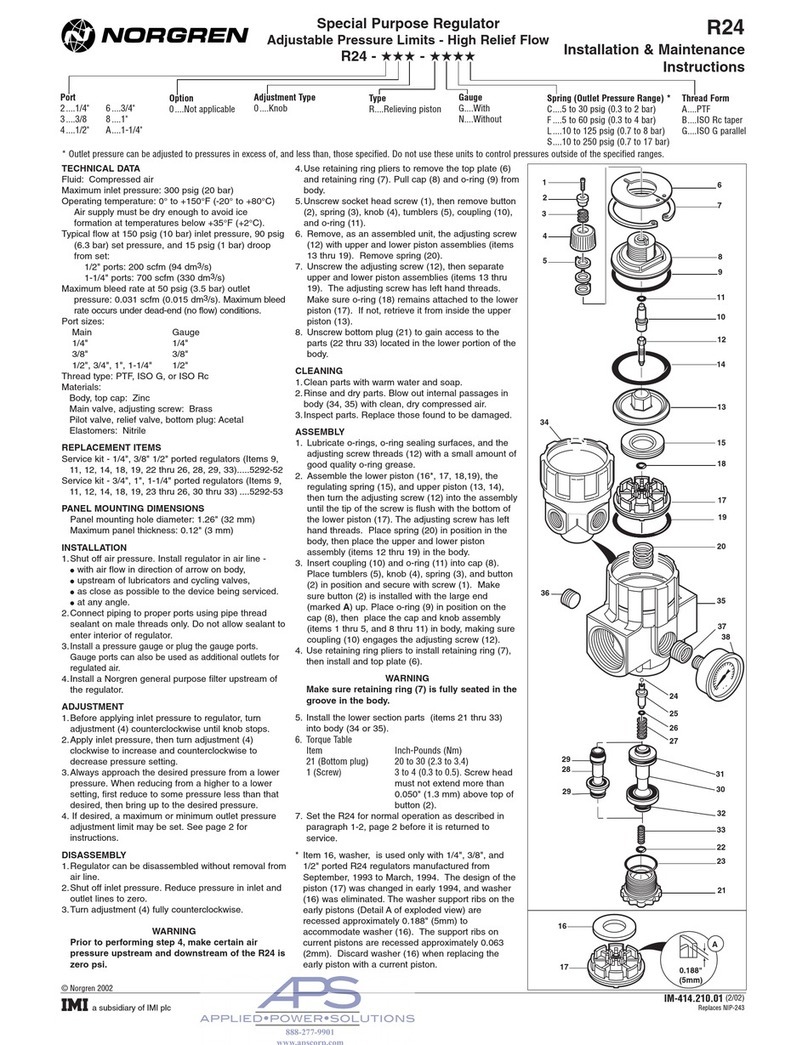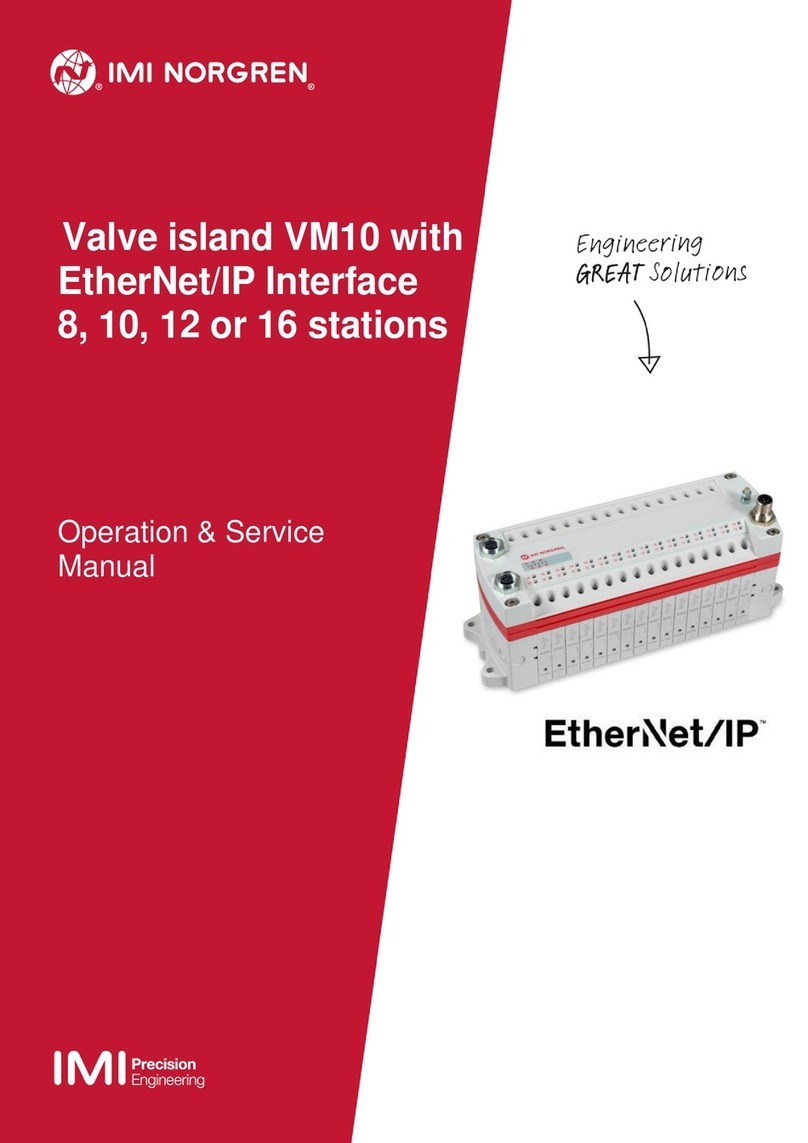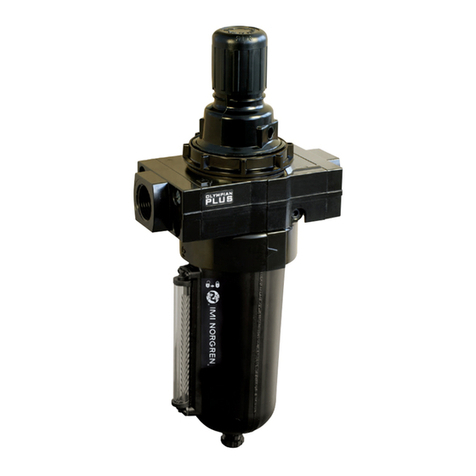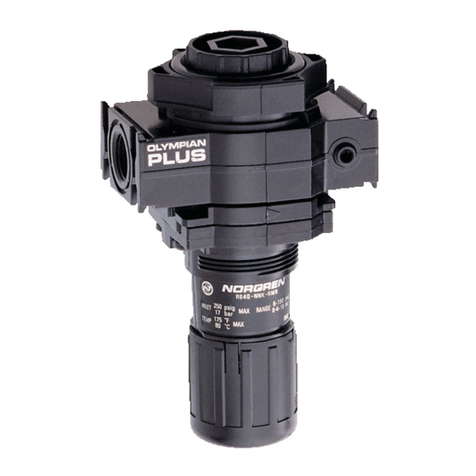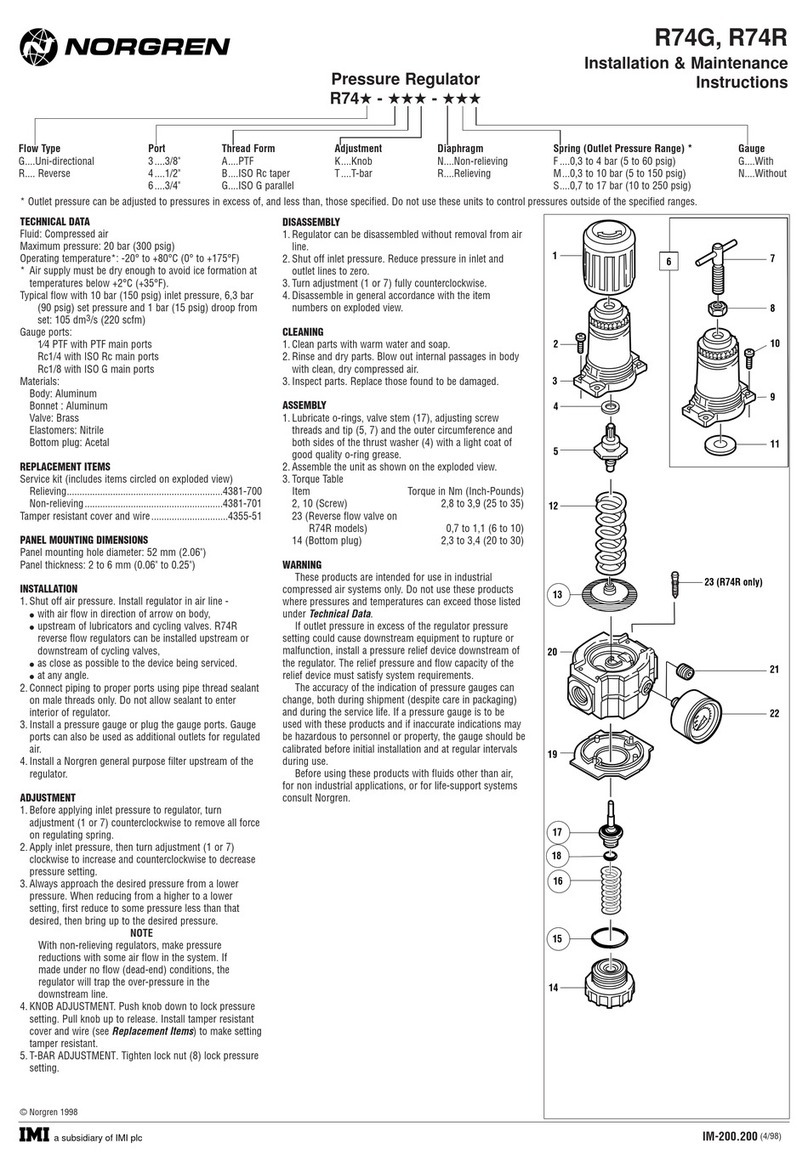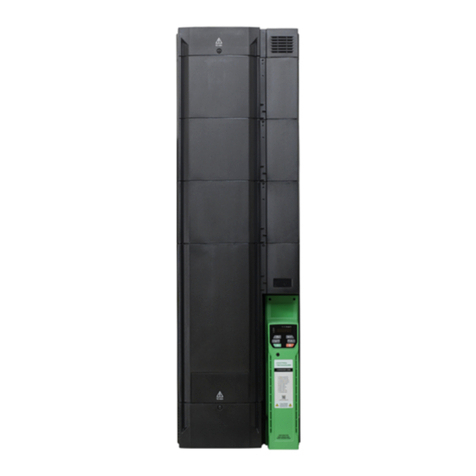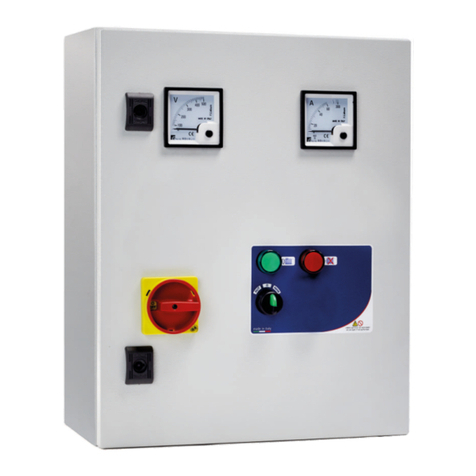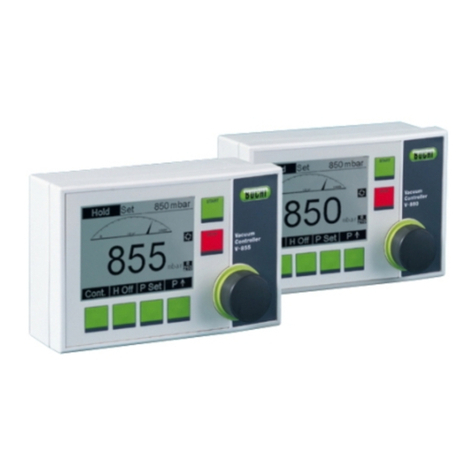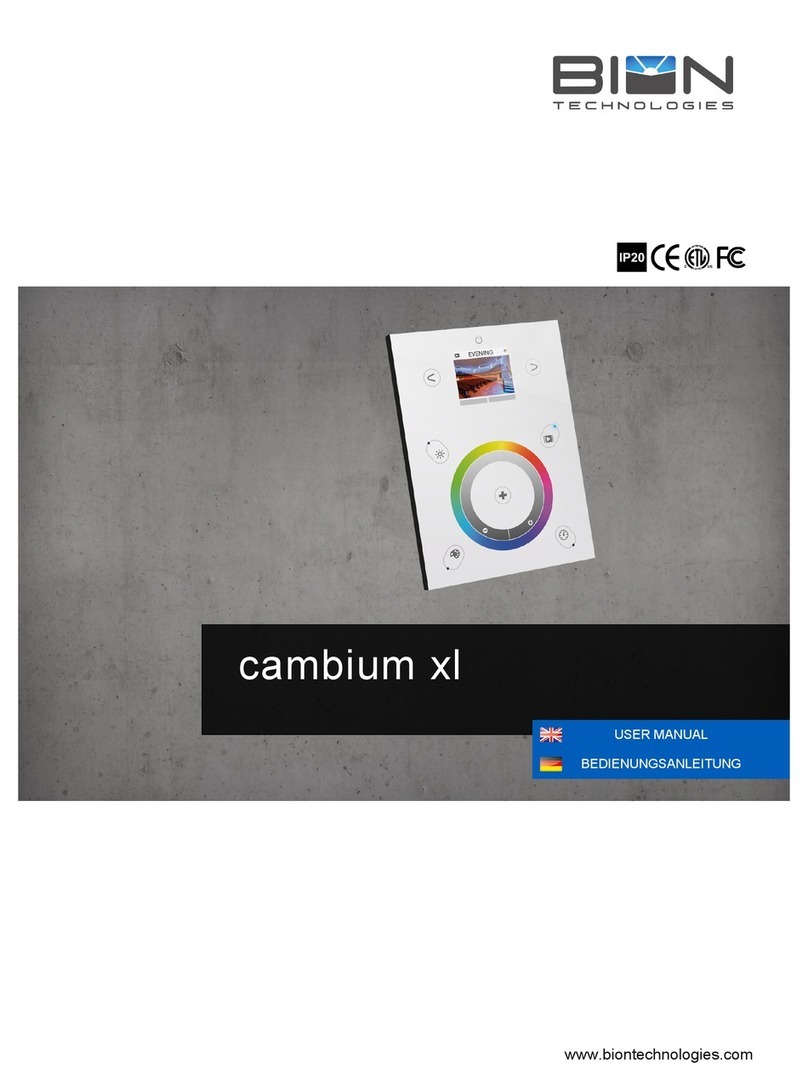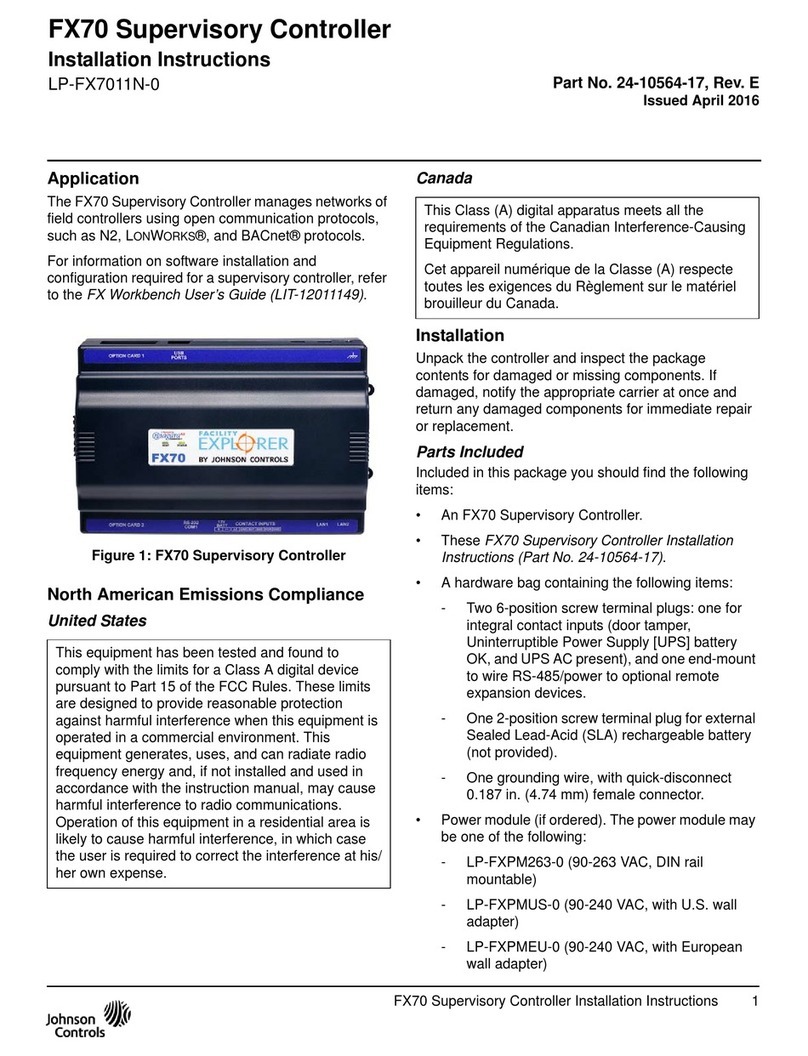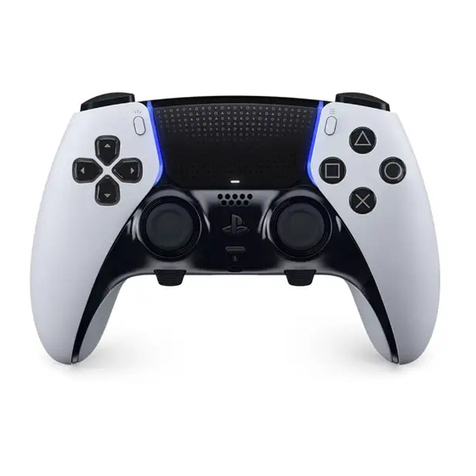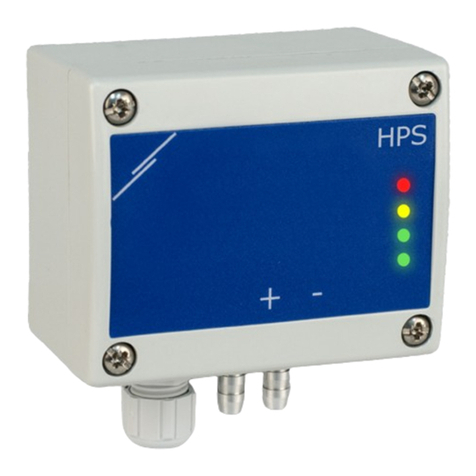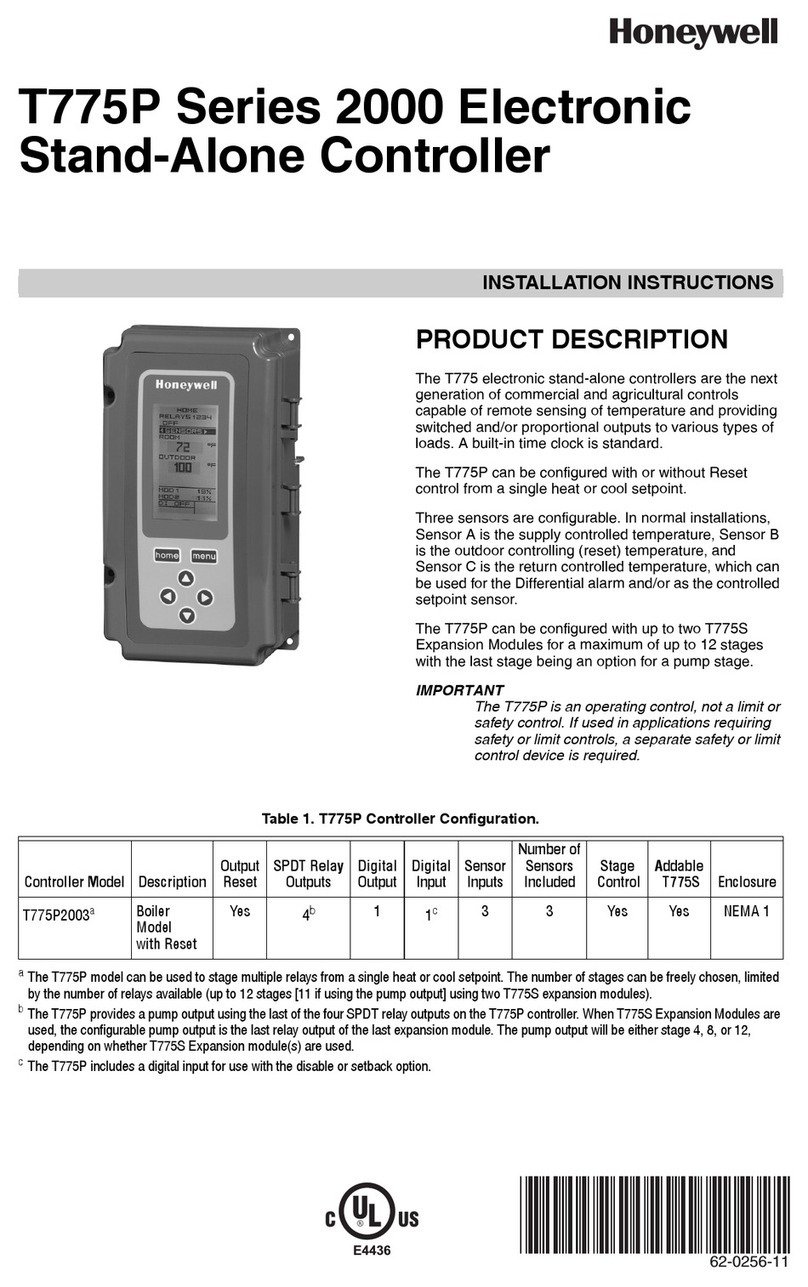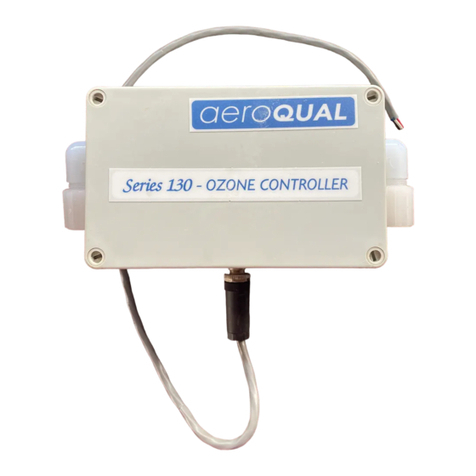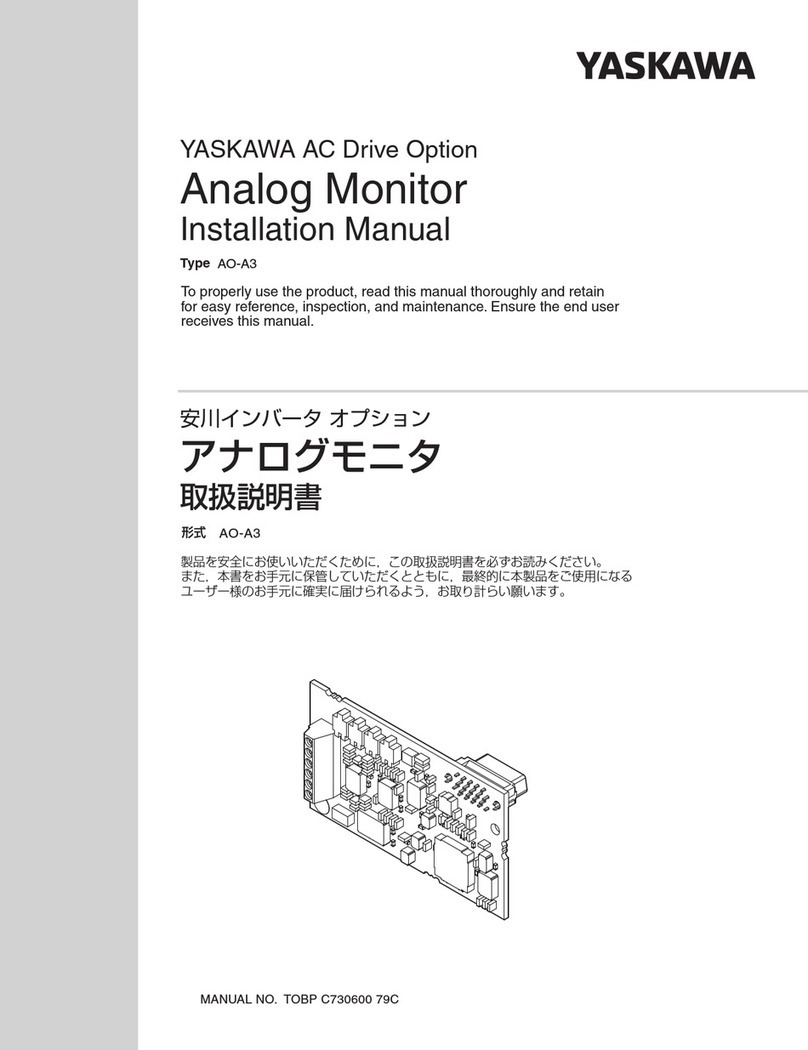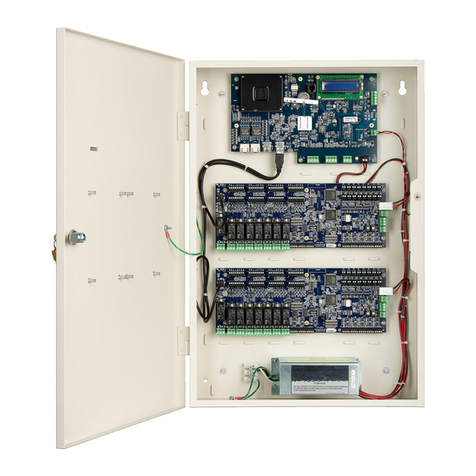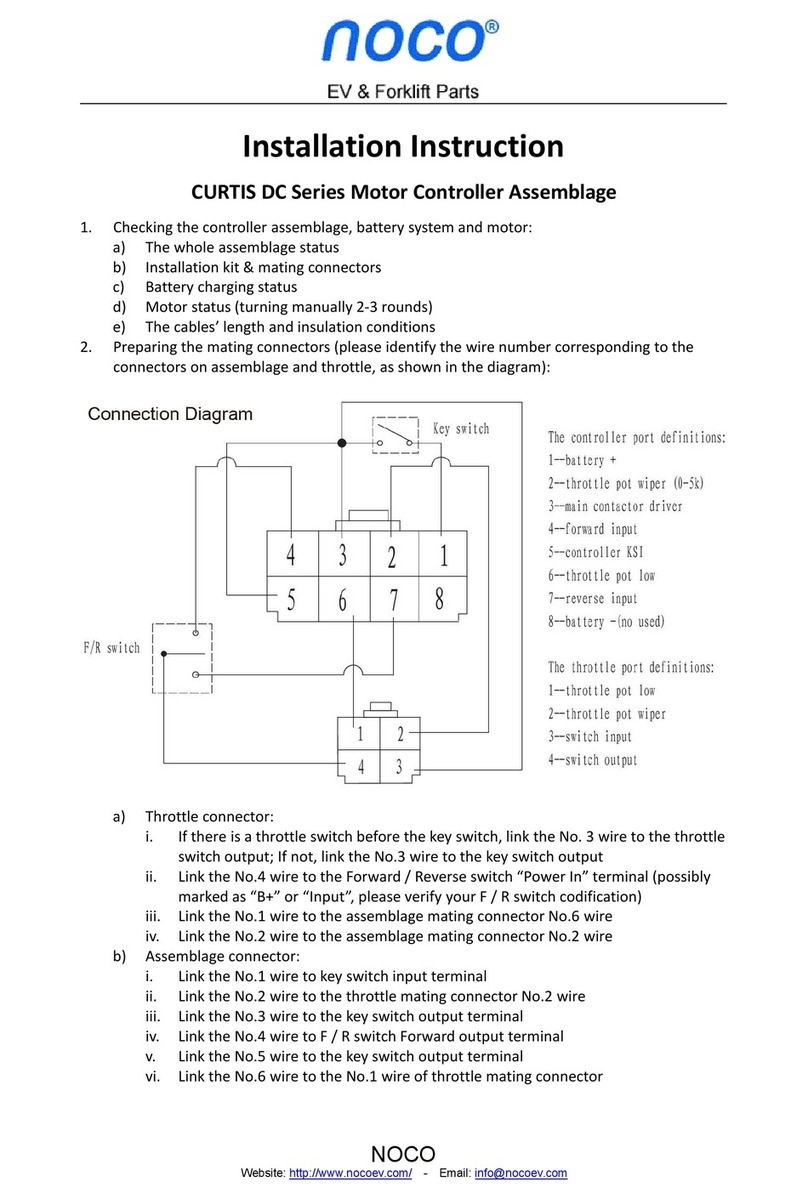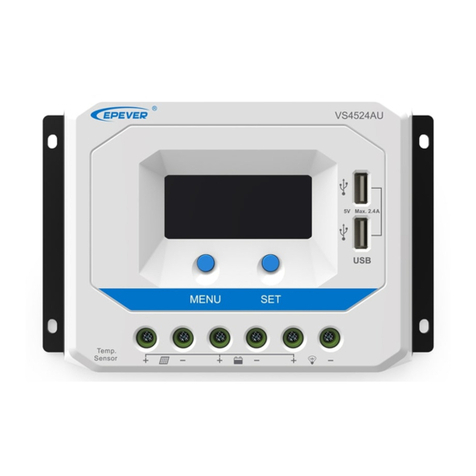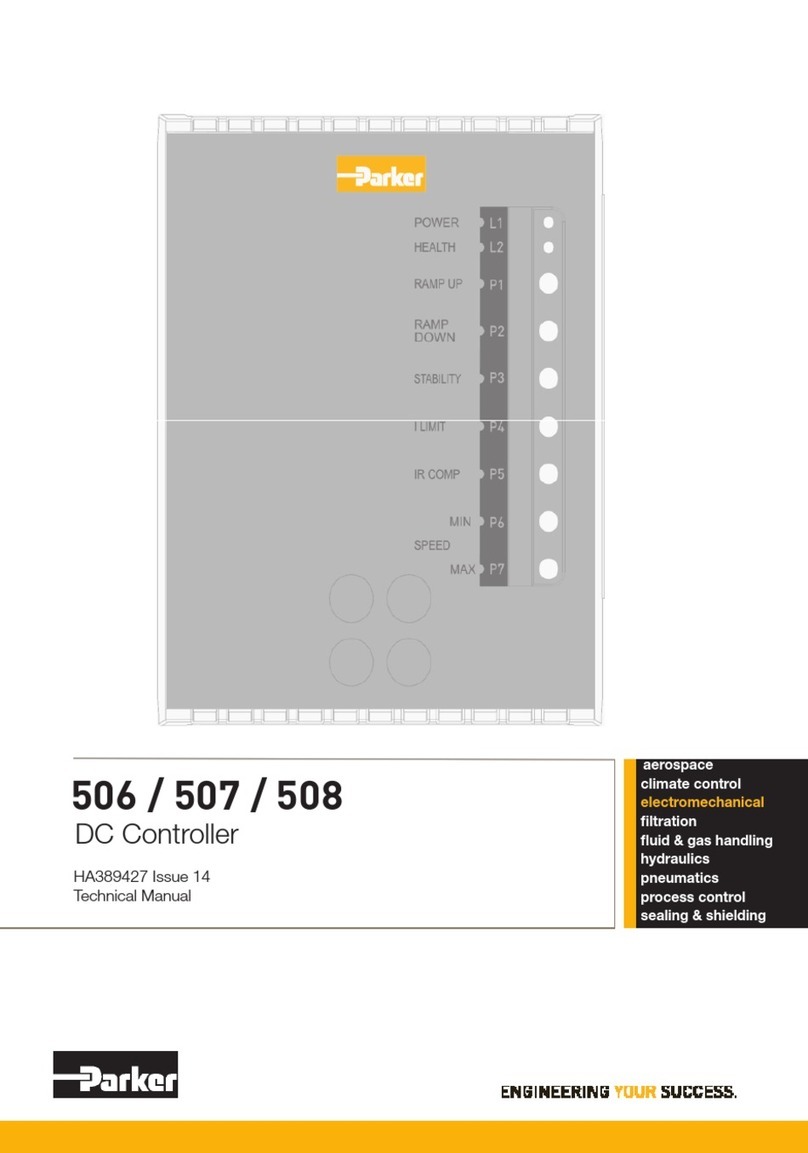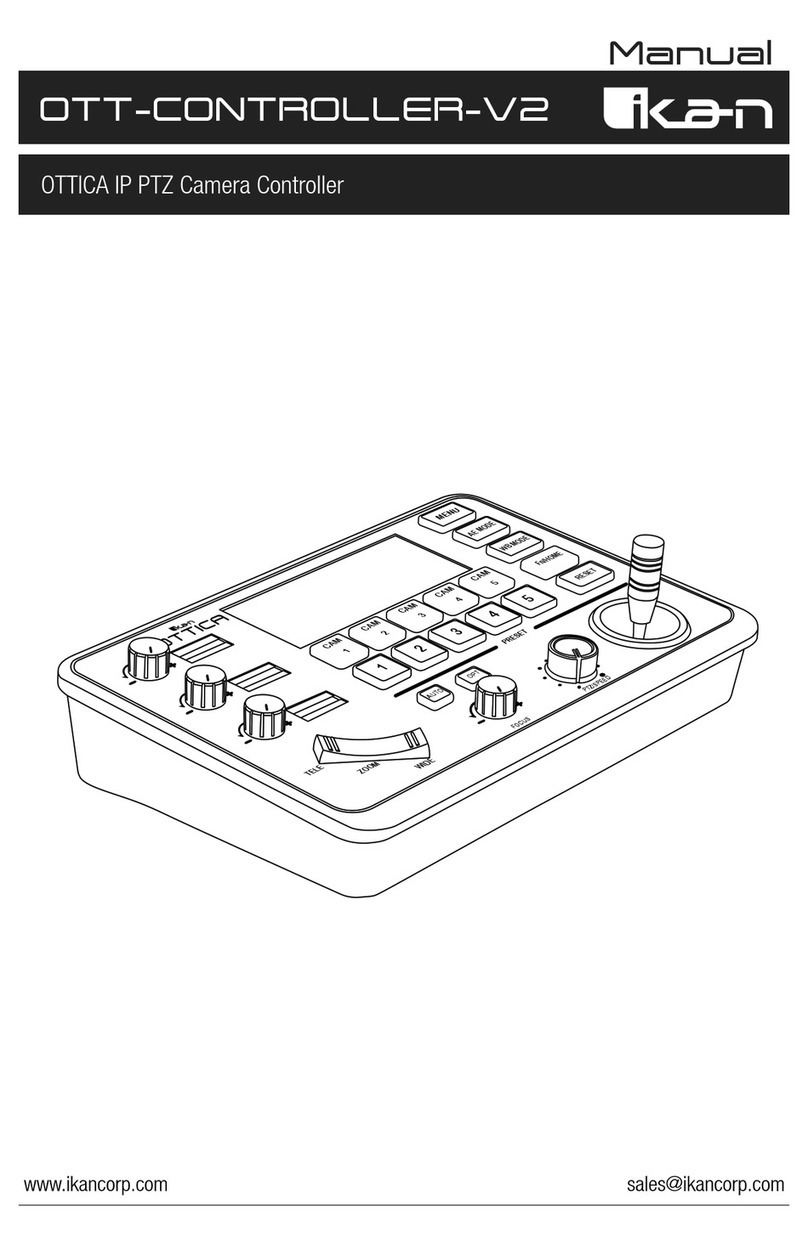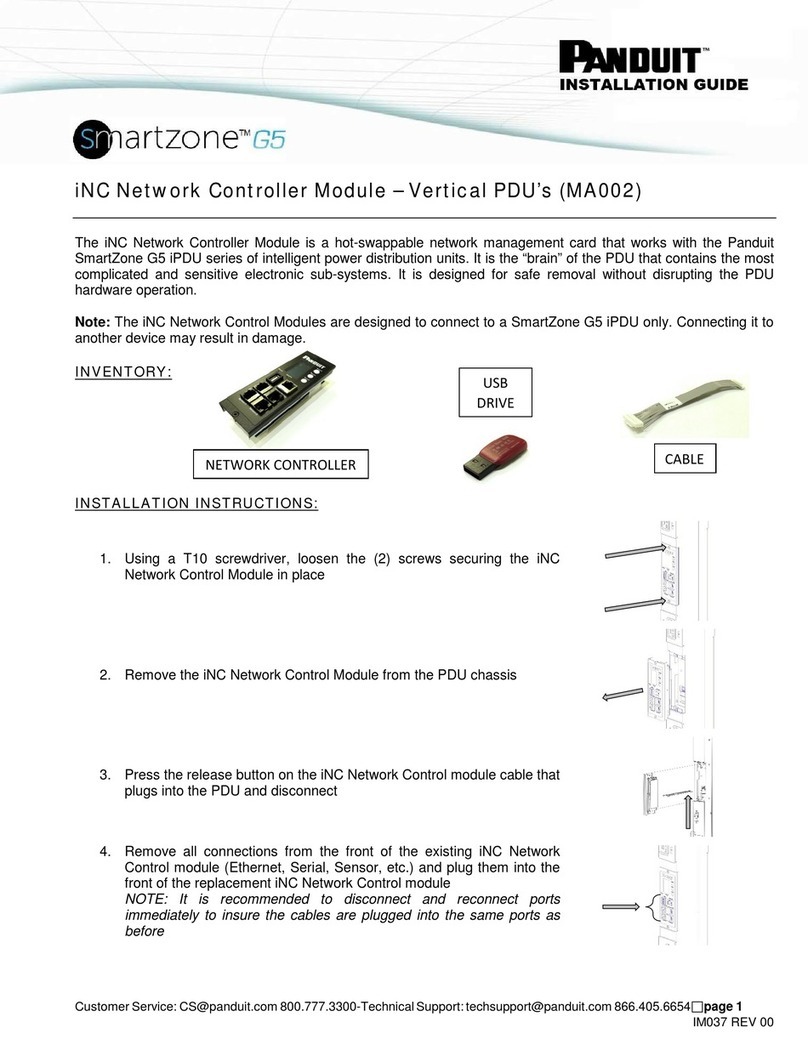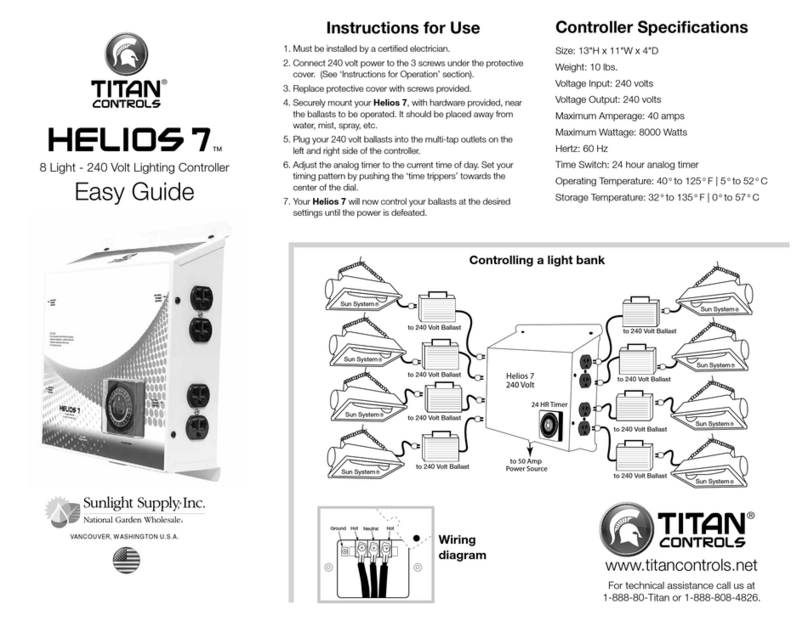
N/IM/en 8.446.305.01
Our policy is one of continued research and development. We therefore reserve the right to amend,
without notice, the specifications given in this document. © 2014 IMI International s.r.o.
1/14 1999-IM8149b
B38 - Installation & Maintenance Instructions
Technical Data
Fluid: Compressed air
Maximum pressure:
Aluminium: 20 bar (300 psig)
Operating temperature*:
-40° ... +80°C (-40° ... +176°F)
* Air supply must be dry enough to avoid ice formati-
on at temperatures below +2°C (+35°F).
Particle removal: 5 μm or 25 μm filter element
Air quality: Within ISO 8573-1, Class 3 and Class 5
(particulates)
Typical flow with 7 bar (100 psig) inlet pressure,
1 bar (15 psig) set pressure and 0,05 bar (1 psig)
droop from set: 8 dm3/s (17 scfm)
Gauge ports:
1⁄4“ as per main ports
Materials:
Body: Aluminium
Bonnet: Aluminium
Bowl: Aluminium
Adjusting screw: steel
Element
5 μm: Stainless steel
25 μm: Vyon
Elastomers: Synthetic rubber
Diaphragm: Nitrile
Valve seat: Stainless steel
Valve spring: Stainless steel
Valve: Nitrile
Valve cap: Aluminium
Replacement items (standard option)
Service Kit (includes items circled on exploded view):
Relieving
2 bar R38-100R
4 & 7 bar R38-101R
Non relieving 4383-501
2 bar R38-100NR
4 & 7 bar R38-101NR
Filter section
5 μm aluminium B38100A(5)
25 μm aluminium B38100A(25)
Panel Mounting Dimensions
Panel mounting hole diameter: 42 mm (1,65”)
Panel thickness: 0 ... 6 mm (0” ... 0,24”)
Installation
1. Shut off air pressure. Install filter/regulator in air
line -
•vertically (bowl down),
•with air flow in direction of arrow on body,
•upstream of lubricators and cycling valves,
• as close as possible to the device being serviced.
2. Connect piping to proper ports using pipe thread
sealant on male threads only. Do not allow sealant
to enter interior of unit.
3. Install a pressure gauge or plug the gauge ports.
Gauge ports can also be used as additional outlets
for regulated air.
Adjustment
1. Before applying inlet pressure to filter/regulator,
turn adjustment (2) counterclockwise to remove
all force on regulating spring (7).
2. Apply inlet pressure, then turn adjustment (2)
clockwise to increase and counterclockwise to
decrease outlet pressure setting.
3. Always approach the desired pressure from a
lower pressure. When reducing from a higher
to a lower setting, first reduce to some pressure
less than that desired, then bring up to the desired
pressure.
NOTE
With non-relieving filter/regulators, make pressure
reductions with some air flow in the system. If
made under no flow (dead-end) conditions, the
filter/regulator will trap the over-pressure in the
downstream line.
4. Once required pressure is achieved tighten
locknut (3) to lock setting.
Servicing
1. Regularly open drain to expel accumulated
liquids.Keep liquids below element retainer (13).
2. At approximately 6 month intervals it is advisable
to remove the bowl assembly by removing the
securing screws (4) and unscrewing the element
retainer (13) to remove the element (15) for
inspection. Since the direction of air flow is from
the inside of the element to the outside, a clean
exterior is not an an indication of freedom from
contamination. If the filter element shows
evidence of blockage, replace with new element.
Clean the element retainer (13) and the upper and
lower gaskets (14) befor replacing the filter
element – avoiding excessive overtightening of the
retainer. Inspect the bowl O-ring (16) for damage
and renew if necessary.
3. Clean or replace filter element when dirty.
Disassembly
1. Filter/regulator can be disassembled without
removal from air line.
2. Shut off inlet pressure. Reduce pressure in inlet
and outlet lines to zero.
3. Turn adjustment screw fully counterclockwise.
4. Disassemble in general accordance with the item
numbers on exploded view. Do not remove the
drains unless replacement is necessary. Remove
and replace drains only if they malfunction.
Cleaning
1. Rinse and dry parts. Blow out internal passages in
body (22) with clean, dry compressed air. Blow air
through filter element (15) from inside to outside
to remove surface contaminants.
2. Inspect parts. Replace those found to be
damaged.
Assembly
1. Lubricate threads and nose of adjusting screw (2)
at regular intervals with suitable grease eg.
Speerol APT2.
2. Lubricate seals (16, 23, 26) with light coat of good
quality grease.
2. Assemble the unit as shown on the exploded view.
3. Torque Table
Item Torque in
Nm (Inch-Pounds)
4 (screws, aluminium model) 3,3 (30)
24 (valve cap, aluminium model) 8 (72)
* Outlet pressure can be adjusted to pressures in excess of, and less than, those specified. Do not use these units to control pressures outside of the specified ranges.
Port
2 1/4“
Mounting Options
0 None
1 Bracket and nut
2 Nut only
3 Handwheel and nut
4 Handwheel with bracket and nut
5 Handwheel
Drain
B....Manual
Material
0....Aluminum with Nitrile elastomers
Spring (Outlet Pressure Range) *
C 0,04 ... 2 bar (0.6 ... 30 psig)
F 0,07 ... 4 bar (1 ... 60 psig)
K 0,25 ... 7 bar (3,6 ... 100 psig)
Thread Form
A PTF
B ISO Rc taper
D ISO G
K API
Aluminum instrument filter/regulator
B38 – ˙˙˙ – ˙˙˙˙
Element
1....5 μm
2....25 μm
1
2
3
4
5
6
7
8
16
14
15
14
13
9
4
23
29
26
25
24
22
27
28
increase and counterclockwise to decrease outlet pressure
setting.
3. Always approach the desired pressure from a lower
pressure. When reducing from a higher to a lower setting,
first reduce to some pressure less than that desired, then
bring up to the desired pressure.
NOTE
With non-relieving filter/regulators, make pressure reductions
with some air flow in the system. If made under no flow
(dead-end) conditions, the filter/regulator will trap the over-
pressure in the downstream line.
4. Once required pressure is achieved tighten locknut (3) to
lock setting.
SERVICING
1. Regularly open drain to expel accumulated liquids.Keep
liquids below element retainer (13).
2. t approximately 6 month intervals it is advisable to remove
the bowl assembly by removing the securing screws (4) and
unscrewing the element retainer (13) to remove the element
(15) for inspection. Since the direction of air flow is from
the inside of the element to the outside, a clean exterior is
not an an indication of freedom from contamination. If the
filter element shows evidence of blockage, replace with
new element. Clean the element retainer (13) and the upper
and lower gaskets (14) befor replacing the filter element –
avoiding excessive overtightening of the retainer. Inspect the
bowl O-ring (16) for damage and renew if necessary.
3. Clean or replace filter element when dirty.
DISASSEMBLY
1. Filter/regulator can be disassembled without removal from
air line.
2. Shut off inlet pressure. Reduce pressure in inlet and outlet
lines to zero.
3. Turn adjustment screw fully counterclockwise.
4. Disassemble in general accordance with the item numbers
on exploded view. Do not remove the drain unless
replacement is necessary. Remove and replace drain only if
it malfunctions.
CLEANING
1. Rinse and dry parts. Blow out internal passages in body
(22) with clean, dry compressed air. Blow air through filter
element (15) from inside to outside to remove surface
contaminants.
2. Inspect parts. Replace those found to be damaged.
ASSEMBLY
1. Lubricate threads and nose of adjusting screw (2) at regular
intervals with suitable grease eg. Speerol APT2.
2. Lubricate seals (16, 23, 26) with light coat of good quality
grease.
3. Assemble the unit as shown on the exploded view.
4. Torque Table
Item Torque In
Nm (Inch-Pounds)
4 (screws, aluminiuml model) 3,3 (30)
24 (valve cap, aluminium model) 8 (72)
TECHNICAL DATA
Fluid: Compressed air
Maximum pressure:
Aluminium: 20 bar (290 psig)
Operating temperature*: -40° ... +80°C
(-40° ... +176°F)*
* Air supply must be dry enough to avoid ice formation at
temperatures below +2°C (+36°F).
Particle removal: 5 μm or 25 μm filter element
Air quality: Within ISO 8573-1, Class 3 and Class 5 (particulates)
Typical flow with 7 bar (102 psig) inlet pressure, 1 bar (14,5 psig)
set pressure and 0,05 bar (0,7 psig) drop from set: 8 dm3/s (17
scfm)
Gauge ports: 1⁄4“ as per main ports
Materials:
Body: Aluminium
Bonnet: Aluminium
Bowl: Aluminium
Adjusting screw: steel
Element
5 μm: Stainless steel
25 μm: Vyon
Elastomers: Synthetic rubber
Diaphragm: Nitrile
Valve seat: Stainless steel
Valve spring: Stainless steel
Valve: Nitrile
Valve cap: Aluminium
REPLACEMENT ITEMS
Service Kit (includes items circled on exploded view):
Relieving
2 bar R38-100R
4 & 7 bar R38-101R
Non relieving
2 bar R38-100NR
4 & 7 bar R38-101NR
Filter section
5 μm aluminium B38-100A-5
25 μm aluminium B38-100A-25
PANEL MOUNTING DIMENSIONS
Panel mounting hole diameter: 41 mm (1.61”)
Maximum panel thickness: 0 ... 6 mm (0 ... 0.24”)
INSTALLATION
1. Shut off air pressure. Install filter/regulator in air line
•vertically (bowl down),
•with air flow in direction of arrow on body.
•upstream of lubricators and cycling valves,
•as close as possible to the device being serviced.
2. Connect piping to proper ports using pipe thread sealant on
male threads only. Do not allow sealant to enter interior of
unit.
3. Install a pressure gauge or plug the gauge ports. Gauge ports
can also be used as additional outlets for regulated air.
ADJUSTMENT
1. Before applying inlet pressure to filter/regulator, turn
adjustment (2) counterclockwise to remove all force on
regulating spring (7).
2.
Apply inlet pressure, then turn adjustment (2) clockwise to
N/IM/en 8.446.305.01
1999-IM8149b (1/14)
Our policy is one of continued research and development. We therefore reserve the right to amend, without notice,
the specifications given in this document. © 2014 IMI International s.r.o.
Installation & Maintenance
Instructions
B38
Aluminium
Precision Filter/Regulator
* Outlet pressure can be adjusted to pressures in excess of, and less than, those specified. Do not use these units to control pressures
outside of the specified ranges.
Material
0 Aluminium with Nitrle
elastomers
Element
1 5 μm
2 25 μm
Drain
B Manual
B38 - HHH - HHHH
Port
2 1/4”
Mounting Options
0 None
1 Bracket and nut
2 Nut only
3 Handwheel and nut
4 Handwheel with bracket and nut
5 Handwheel
Spring (Outlet Pressure Range) *
C 0,04 ... 2 bar (0,6 ... 29 psig)
F 0,07 ... 4 bar (1 ... 58 psig)
K 0,25 ... 7 bar (3,6 ... 102 psig)
Thread Form
A PTF
B ISO Rc taper
D ISO G
K API


